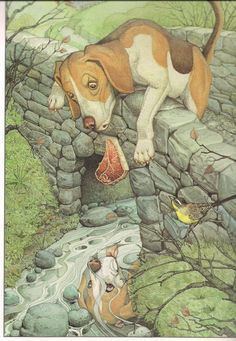 | ||
Similar Aesop books, Other books | ||
The dog and its reflection fables by shapes
The Dog and its Reflection (or 'Shadow' in several translations) is one of Aesop's Fables and is numbered 133 in the Perry Index. An indication of how old and well-known this story was is given by a mere allusion to it in the work of the philosopher Democritus from the 5th century BCE. Discussing the foolish desire for more, rather than being content with what one has, he describes it as being 'like the dog in Aesop's fable.'
Contents
Fable
In the story, a dog that is carrying a stolen bone, or piece of meat or cheese, looks down as it is crossing a stream and sees its own reflection in the water. Taking it for another dog carrying something better, it opens its mouth to bark at the "other" and in doing so drops what it was carrying. The story became incorporated into mediaeval animal lore. The Aberdeen Bestiary, written and illuminated in England around 1200, asserts that 'If a dog swims across a river carrying a piece of meat or anything of that sort in its mouth, and sees its shadow, it opens its mouth and in hastening to seize the other piece of meat, it loses the one it was carrying'.
The story's moral, according to John Lydgate's versified Isopes Fabules, is that the one 'Who all coveteth, oft he loseth all.' Making use of a picture of the fable in his Book of Emblemes (1586), the poet Geoffrey Whitney gives his moral lesson the Latin title Mediocribus utere partis (Make use of moderate possessions):
Jean de La Fontaine (Fables VI.17) also prefaces his version of the fable with the moral to be drawn from it before proceeding to a brief relation of the story. For him, the point is not to be taken in by appearances. In his account, the dog attacks its reflection and falls into the water. As he struggles to swim to shore, he relaxes his grip on his plunder and loses both 'shadow and substance'.
Others in the 16th century had already treated the subject in an emblematic way. They include Latin versions by Gabriele Faerno (1563), Hieronymus Osius (1564) and Arnold Freitag (1579) and a French version by Bernard Salomon (1547). How the fable is illustrated depends on which source is being drawn upon. Greek versions generally state that the dog is crossing the river and some pictures have it paddling across. Phaedrus states that it is swimming (natans) in the water and in this is followed by Osius and Salomon. On the other hand, one of the Romulus versions specifies that it is crossing a bridge (per pontem), which has been the preference for the majority of illustrators.
A story close to Aesop's is inserted into the Calladhanuggaha Jataka, where a jackal bearing a piece of flesh goes by a river bank and plunges in after the fish it sees swimming there. On returning from its unsuccessful hunt, the jackal finds a vulture has carried off its other prey. A variation deriving from this is Bidpai's story of "The Fox and the Piece of Meat". There a fox is on its way home with the meat when it catches sight of some chickens and decides to hunt one of them down; it is a kite that flies off with the meat in this version.
